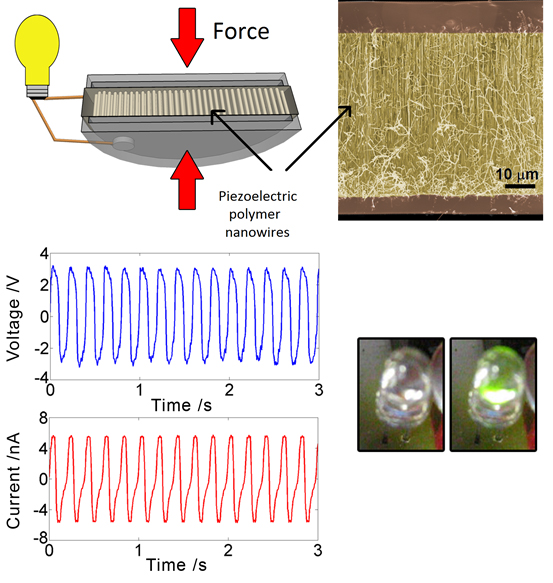
Professor of Device & Energy Materials
MS Indian Institute of Science
PhD Indian Institute of Science
Nanogenerators & Sensors
My research within the Device Materials Group aims at developing polymer-based nanomaterials for applications in energy harvesting and sensing. My work involves piezoelectric, ferroelectric, magnetoelectric and thermoelectric nanostructures for harvesting and harnessing ambient waste energies. I focus on employing scalable and low-cost physical and chemical synthesis approaches to fabricate novel phases and functional nanostructures for incorporation into devices, with the aim of developing early-stage prototypes and eventual commercialization of energy harvesting and self-powered sensing technologies.
Polymer-based materials and devices for mechanical energy harvesting
Energy harvesting (EH) from ambient vibrations has enormous potential for small-power applications such as wireless sensors, flexible, portable and wearable electronics, and bio-medical implants. Nanoscale piezoelectric energy harvesters, also known as nanogenerators (NGs), can directly convert small-scale ambient vibrations into electrical energy. Ceramics such as lead zirconium titanate and semiconductors such as zinc oxide are the most widely used piezoelectric EH materials. In my group, we instead focus on a different class of piezoelectric materials, namely ferroelectric polymers, such as polyvinlyidene fluoride (PVDF), its copolymers, and odd-numbered Nylons. These are potentially superior EH materials as they are flexible, robust, lightweight, easy and cheap to fabricate, as well as being lead-free and bio-compatible.
Piezoelectricity in biology
There is growing evidence that biological systems are exceptionally sensitive not only to their chemical environment, but also to their mechanical environment. This is the fundamental principle behind the emerging field of ‘mechanobiology’. Understanding exactly how biology responds to these physical stimuli could have significant implications for biomedical implants, regenerative medicine and bio-inspired materials. Research within my group is concerned with the use of piezoelectric nanomaterials to interface mechanically with cellular systems, with the view of creating tools for mechanobiology – a ‘piezoelectric lab-on-a-chip’.
Flexible printed thermoelectric generators
My group works on developing a new class of nanocomposite thermoelectric (TE) materials that can be incorporated into thermal energy harvesters as a clean, green, efficient and competitive energy technology. Flexible and robust thermoelectric nanogenerators (ThENG) based on hybrid organic-inorganic nanocomposites are being developed via a state-of-the-art yet cost-effective, scalable and low-temperature aerosol jet printing (AJP) fabrication technique, with the combination of our in-house simple but high-yield nanoparticle-synthesis methods. The as-printed flexible ThENGs are particularly attractive for wearable electronic devices.
Advanced scanning probe microscopy (SPM) techniques
We employ electromechanical (piezoresponse), mechanical (quantitative nanomechanical mapping) and electrical (Kelvin-probe) force microscopy to examine basic properties of various piezoelectric materials at the nanoscale, motivated by the desire to improve energy harvesting efficiency, and mechanical sensing. SPM on nanostructures is particularly challenging, and hence we develop novel methodologies to probe a variety of physical properties at the nanoscale. Our techniques are applicable to a wide range of novel nanomaterials such as nanowires of piezoelectric polymers, biomaterials and III-V semiconducting materials.
Magnetoelectric nanocomposites for energy and sensing applications
Energy stored in stray magnetic fields is ubiquitous, particularly around electronics such as electricity pylons or electromagnetic radiation from wireless transmitters. Magnetoelectric composite devices can convert magnetic fields into useful energy in the form of electricity. They consist of piezoelectric materials in contact with ferromagnetic ones. Ferromagnetic materials exhibit magnetostriction, an effect that causes them to change shape in a magnetic field. This shape change strains the piezoelectric component and a voltage is generated. The same effect can be used to sense small magnetic fields using magnetoelectric nanocomposites
- A. Datta, Y. Sik Choi, E. Chalmers, C. Ou, S. Kar-Narayan, "Piezoelectric Nylon-11 Nanowire Arrays Grown by Template Wetting for Vibrational Energy Harvesting Applications", Advanced Functional Materials 27, 1604262 (2017).
- M. Smith, Y. Calahorra, Q. Jing & S. Kar-Narayan, "Direct Observation of Shear Piezoelectricity in Poly-L-lactic Acid Nanowires", APL Materials 5, 074105 (2017).
- A. Datta, A. Sangle, N. Hardingham, C. Cooper, M. Kraan, D. Ritchie, V. Narayan & S. Kar-Narayan, "Structure and Thermoelectric Properties of Bi2-xSbxTe3 Nanowires Grown in Flexible Nanoporous Polycarbonate Templates" Materials 10, 553 (2017).
- Y. Calahorra, R.A. Whiter, Q. Jing, V. Narayan, S. Kar-Narayan, "Localized electromechanical interactions in ferroelectric P(VDF-TrFE) nanowires investigated by scanning probe microscopy", APL Materials 4, 116106 (2016).
- R.A.Whiter, V. Narayan & S. Kar-Narayan, “A scalable nanogenerator based on piezoelectric polymer nanowires with high energy conversion efficiency”, Advanced Energy Materials 4, 1400519 (2014).

